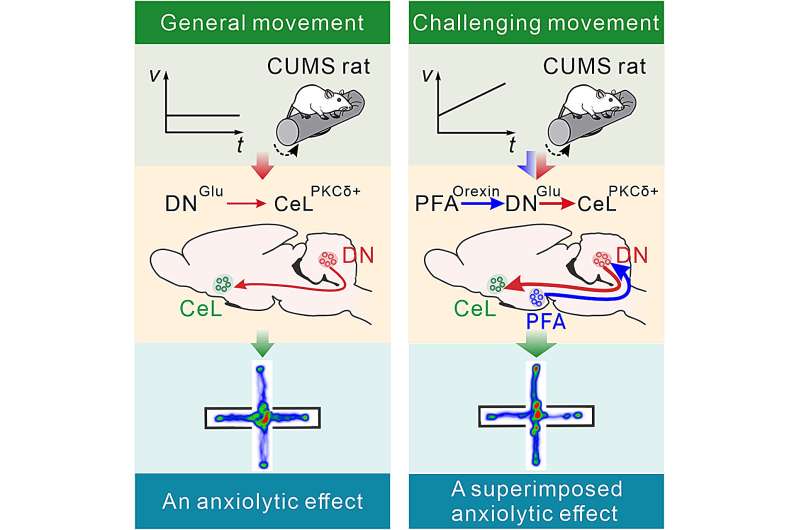This article has been reviewed according to Science X's editorial process and policies. Editors have highlighted the following attributes while ensuring the content's credibility:
fact-checked
peer-reviewed publication
proofread
Study finds brain mechanism that may explain how physical exercise improves mood

"Only exercise can remove all kinds of doubts," Goethe said. Physical exercise is the lubricant between the body and the mind. Alleviation of anxiety by motor activity forms an integral part of our daily life; whether going for a walk to refresh our mind or running excessively in the park to recuperate from a stressful event, we are all well aware of the beneficial impact.
In fact, the plain view that exercise can prevent anxiety and depression has been supported by accumulating prospective cohort studies in recent years. Yet, apart from some general interactions between the periphery of our body and our central nervous system, it has remained unclear which mechanisms inside our brain underlie this process of motor-dependent anxiolysis.
In a recent study titled "A role for the cerebellum in motor-triggered alleviation of anxiety" published in the journal Neuron, Dr. Jing-Ning Zhu's group from the School of Life Sciences at Nanjing University explores a hypothalamo-cerebello-amygdalar circuit that may mediate motor-dependent alleviation of anxiety. This three-neuron loop, in which the cerebellum takes center stage, bridges the motor system with the emotional system.
The cerebellum is the largest subcortical motor structure. The attention to the potential role of the cerebellum in higher functions, including emotion and cognition, next to that for sensorimotor coordination, has been increasing. It has been implicated in orchestrating and integrating somatic and non-somatic activities to generate an appropriate behavioral response to changes in external and internal environments.
However, little is known about whether there are direct neural connections between the cerebellum and the limbic system, which is responsible for emotional regulation. Notably, the study finds a trend of negative correlation between cerebello-amygdalar functional connectivity and the Hamilton Anxiety Rating Scale (HAMA) score in patients with bipolar disorder, suggesting an interaction between two brain regions that may be related to anxiety.
By employing the trans-monosynaptic retrograde rabies tracing and fluorescence micro-optical sectioning tomography (fMOST), the researchers map, for the first time, the long-range direct afferent projections from the cerebellar nuclear neurons to amygdala neurons at the mesoscopic scale in rodents, suggesting that the cerebello-amygdalar circuit appears well conserved among species.
Furthermore, using miniature fluorescence microscopy, they find amygdala neurons are activated while rats are running on a rotating rotarod, and among them, the majority also respond to optogenetic stimulation of the cerebellar nuclei, indicating that the cerebello-amygdalar projections carry exercise-dependent information.
Electrophysiological results show that the cerebello-amygdalar projections are monosynaptic glutamatergic and can not only excite but also evoke long-term potentiation in amygdala neurons, which may account for the persistent effect of exercise on mood. Opto-/chemo-genetic activation of cerebello-amygdalar projections significantly ameliorates anxiety, while chemogenetic suppression of the projections eliminates the anxiolytic effect of rotarod running.
So, what kind of motor paradigm can more effectively improve anxiety? Based on their previous findings that hypothalamic neuropeptide orexin not only helps to cope with motor challenges but also promotes stress resilience, the researchers find that challenging animals on an accelerated rather than a constant rotarod engages hypothalamic neurons that provide a superimposed anxiolytic effect via an orexinergic projection to the cerebellar nuclear neurons that activate the amygdala. Thus, the hypothalamo-cerebello-amygdalar loop may exert anxiolytic effects at two levels of intensity, operating like an engine with multiple transitions.
"The results advance our understanding of cerebellar nonmotor functions and the neural mechanisms underlying motor-emotional interaction and somatic-nonsomatic integration," said Jing-Ning Zhu. "The findings may also shed light on developing more effective movement prescriptions for anxiety and mood disorders in general, such as high-intensity interval training (HIIT) or vigorous intermittent lifestyle physical activity (VILPA), and provide a novel strategy for both invasive and non-invasive forms of interventions targeting cerebellum to alleviate anxiety."
More information: Xiao-Yang Zhang et al, A role for the cerebellum in motor-triggered alleviation of anxiety, Neuron (2024). DOI: 10.1016/j.neuron.2024.01.007


















